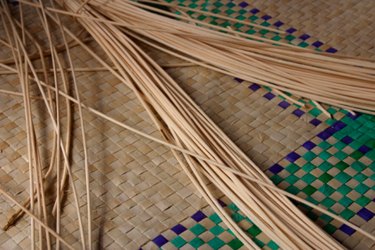
Basket-weaving is not as popular as it once was. With the turn of the 20th century, the popularity of basket-weaving declined as other methods for storing and carrying items were introduced. However, despite the decrease in necessity, basket-weaving continues to be an art form practiced today. A variety of methods and materials are used to create baskets. Popular basket-weaving styles include basic weaving, coiled, and twined.
Coiled
Video of the Day
Coiling basket-weaving involves stitching coils of grass together. The grasses are coiled first. Then, the coils are stitched together. As the coils are stitched together, they are arranged to create a basket. This method of basket-weaving is ideal for soft materials such as grass because of the manipulation necessary to create the coils. Harder materials such as bark will crack, splinter, or break if coiled.
Video of the Day
Twined
Twining is a method used by more advanced weavers. Twine baskets use three strands of material to weave a basket. The base of the basket, also called ribs, is made with a harder material such as cedar bark. Two softer materials such as day lilies are woven in opposite directions up and over the basket's ribs. Having to weave two materials in different directions is what makes this a more advanced weaving technique.
Basic Weaving
A basic woven basket starts with a sturdy base. Stakes are made from harder materials and arranged around the sides, or wafts, of the baskets. Then, flexible materials are woven under and over the stakes. Any material that can be gently bent to weave under and over the stakes, which allows for different looks of baskets to be made depending on the material used.
Basket-weaving Tools
Regardless of what type of basket-weaving is used for a project, there are tools necessary to complete it. Many of the tools can be found at craft or hardware stores. A straight-edge knife with a sharpener is necessary along with a cutting board for cutting strips of grasses, bark and other weaving materials. The cutting board can also protect the work surface from scratches and dings. Clamps for holding materials in place are needed, but clothes pins can also be used. A small container for holding water as well as a sponge to dampen the materials before using are required. Needle-nose pliers are another tool that act as another pair of hands to weave material in hard-to-reach or tight places. Awnings can be used to push the materials closer together for a tighter weave. Pruning shears, diagonal cutting pliers, and a miter saw should be kept on hand for cutting through thicker material. A reed gauge is ideal for measuring the width of basket weaving materials before using to ensure they are the right size. When the basket is finished, use a fine-grit sandpaper to smooth out any rough areas.